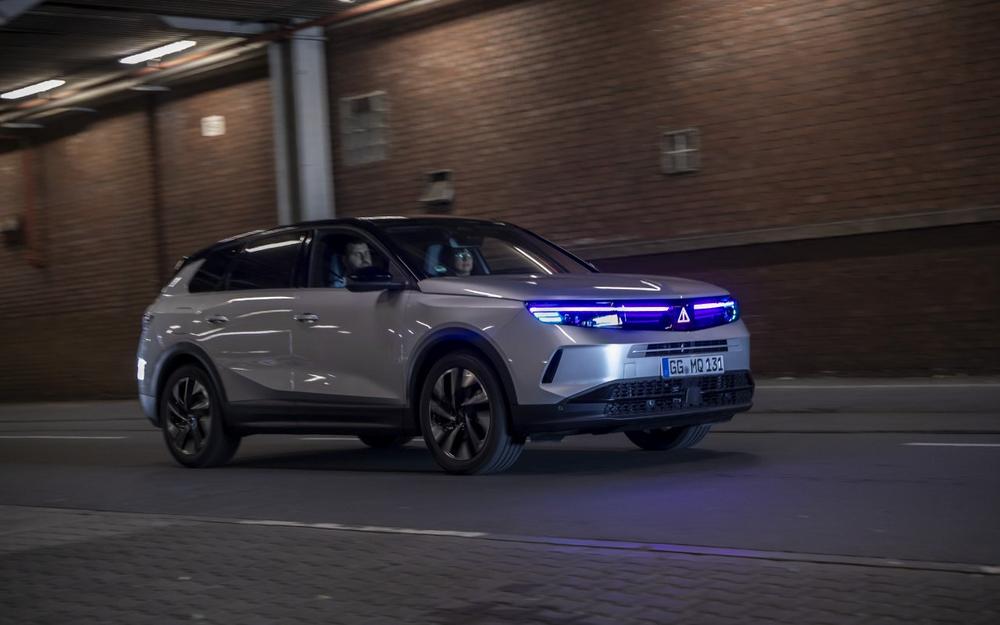- Pioneer in lighting innovations: Sophisticated headlight systems already available in numerous Opel models
- In-house creation: Team in Rüsselsheim creates unique demonstrator car with signature lighting innovations
- Ongoing cooperation: Opel, Stellantis and the TU Darmstadt have been conducting joint research into new lighting technologies since 2022
At this year’s International Symposium on Automotive Lighting (ISAL), which is currently taking place in Darmstadt until September 24, Opel, Stellantis and the Technical University of Darmstadt (TU Darmstadt) are present with a special Opel Grandland. The test vehicle demonstrates how SAE Level 3-capable (hands-off, eyes-off) autonomous vehicles could communicate with other road users via lighting systems in future.
Making pioneering lighting technologies available to customers is a long-standing tradition at Opel. Opel’s lighting innovations currently available in various models with the Blitz include:
- Intelli-LED: featured in Corsa and Mokka
- Intelli-Lux Matrix: available in Corsa, Mokka, and Combo
- Intelli-Lux Pixel Light: showcased in Astra and Astra Sports Tourer
- Intelli-Lux HD Light: debuting in the new Grandland
At Opel, lighting innovation goes beyond enhancing visibility: it’s about creating safer, smarter interactions on the road. At the International Symposium on Automotive Lighting in Darmstadt, Philipp Röckl, Global Lead Lighting at Stellantis, and Julisa Le, Lead Innovation Engineer, will present a forward-looking concept: how autonomous vehicles can use light to communicate with pedestrians and other road users. To bring this idea to life, the team collaborated with the Opel Concept Workshop and students from TU Darmstadt to develop a unique Opel Grandland demonstrator.
“Headlights clearly play an important part in increasing road safety – but modern lighting systems are capable of so much more. For example, lighting signatures can easily be animated and used for animations. And the illuminated Blitz on the Grandland can be substituted by a display that can both show the illuminated emblem and be used to communicate with other road users and pedestrians. By using existing lighting elements, it makes it easy to add communication features once we will introduce autonomous driving features in our cars” said Röckl.
To demonstrate what cars of the future could be capable of, the team first defined the use cases, those being ‘possible danger from a pedestrian or other situation’ and ‘the situation is safe and the danger from a pedestrian is no longer present’. In simpler terms, this represents situations that most motorists have encountered such as a child chasing a ball onto the road or a pedestrian emerging from between two parked cars. With this in mind, the team then fitted the Grandland with a camera system for object and gesture detection, as well as intention prediction using artificial intelligence. And then set about refining the lighting systems.
When operating in SAE Level 3 or higher, the front and rear indicators of the Grandland permanently shine in cyan – giving a clear signal to other road users. At the same time, the remaining signature lighting remains in the usual white. When the camera systems detect a pedestrian in the path of the vehicle, the signature lighting changes to magenta and the display shows a warning signal in the same colour thus visually notifying the pedestrian the car is approaching. At the same time, the vehicle begins to decelerate. Once the Grandland has come to standstill, the signature lighting changes to green and the display shows a green walking figure known from pedestrian crossing lights to indicate that the car has recognised the danger, come to a halt and that the pedestrian can now cross. In the event that the situation cannot be managed by the AI algorithm, the driver is prompted to take control of the vehicle, in line with industry standards for ADAS protocols.
“We specifically chose colours that are not already associated with other vehicle functions to avoid misunderstandings. For example, red is intuitively understandable, but it is already used for stop lights or the rear lights of cars. Cyan and magenta have been thoroughly evaluated for perception purposes and are currently not present in any traffic situations. Both ensure clear, unambiguous communication with other road users,” added Le.
This innovation reflects Opel’s commitment to accessible, intelligent safety for all road users while simultaneously building trust in autonomous vehicles.
Opel, Stellantis and the TU Darmstadt started joint research into new lighting technologies in 2022. The cooperation is part of the global Stellantis research network with respected universities. In the so-called ‘OpenLabs’, scientific knowledge is gained for use in technology systems of future vehicle generations. The strategic partnership with TU Darmstadt will enable a new era of lighting technologies. In addition, Stellantis is currently funding three doctoral students at the university’s Department of Electrical Engineering and Information Technology.
Opel Automobile GmbH
Bahnhofsplatz 1
65423 Rüsselsheim
Telefon: +49 (6142) 7-70
Telefax: +49 (6142) 77-8409
http://de-media.opel.com/de
Telefon: +49 (6142) 6922084
E-Mail: colin.yong@opel-vauxhall.com
Telefon: +49 (6142) 6921679
E-Mail: matthias.meyer@opel-vauxhall.com
![]()
